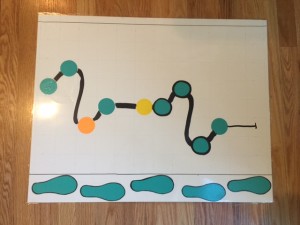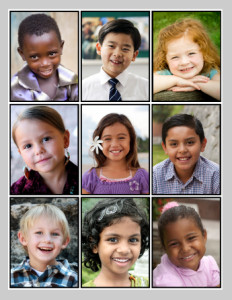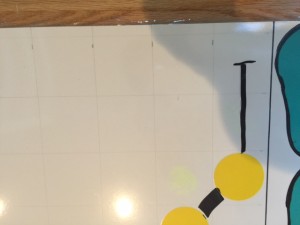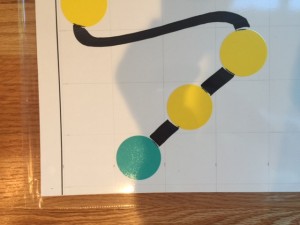Many times I have recommended that we use a melody map for the children because of the way they grasp the song so well with this activity. I just had someone message me about her experience with this activity. She said “We did this today as a review and our primary LOVED it! We were able to SING, SING, SING, SING and they didn’t even notice we sang (the song) 7 times in a row!”
So…
What is a melody map? What does it look like? Is there only one kind of melody map?
Why do I use a melody map? What’s the best way to use it?
How do you make a melody map?
Answering the questions…
What is a melody map?
A melody map is a colorful poster with different shapes that are a map of the melody of the song.
Usually there is one phrase (a musical sentence) per poster board. Often there will be at least 4 poster boards.
There are all kinds of maps…
blocked graphs
dots connected with lines
other cutouts connected with lines
Why should I use a melody map?
Because of the intense concentration as the children try to it figure out.
Because of the literal visual map it gives to the children in their heads of the melody going up and down in a song, and where the words fit into those ups and downs.
Because of the linking in the brain of words and melody both visually and with hearing.
Because it is fun for the children!<smile>
How would you use a melody map?
“What do you see? What do you notice?” As I give this question to the children, they are drawn in to the activity personally. “Squiggly lines!” “Mountains!” “A snake.” “Different colors.” The answers begin to pop out as the children answer from their own perspective.
Then I ask, “What does this map have to do with this song?” I sing the song and occasionally point to the map. See different examples on this site of melody maps.
How do you make a melody map?
Step 1
To make a melody map, you look at the song you would like to present to the children.
1. What is the lowest note?
2. What is the highest note?
3. How many notes are in between?
For example this year I made a melody map for the hymn, Come Follow Me. The second note of the song is as low as the song goes (Middle c). The 5th note from the very end is the highest note in the song (c above middle c). When I count the notes starting with the lowest and going to the highest, I count 8.
Middle c = 1
d = 2
e = 3
f = 4
g = 5
a = 6
b = 7
c = 8
Step 2
Look at the song and write songs in numbers (see above). Group them in phrases (like sentences).
For example – the first line of Come Follow Me
e, c, f, e, g, high c, b, a, g (3, 1, 4, 3, 5, 8, 7, 6, 5)
The third line of Come Follow Me has a flat on the e. I assign flats or sharps a 1/2. Sharps are up 1/2, and flats are down 1/2.
For example – the third line of Come Follow Me.
e flat, e flat, e flat, d, d, d, e flat, d, b
(2 1/2, 2 1/2, 2 1/2, 2, 2, 2, 2 1/2, 2, 7)
Step 3
Take out your poster board and measure off a border (usually 1 or 2 inches).
Divide the inner space inside the border into 8 parts. (I did 2 inch increments.)
Draw a grid with those measurements onto your poster board.
Step 4
Decide if you want to use any different colors on your map. I used yellow on this map for words about Jesus. I used orange for words about us. I used the color teal for all the rest of the words.
Cut circles (squares, clouds, arrows, whatever you choose) in the colors you will need for the words you are representing with certain colors.
Paste them on the grid according to the note in the song (#5 or #3 etc.). Draw a line in-between the circles to connect them.
Hint #1: I label the back of the poster board with what song it is and which poster board this particular one is out of how many. Ex. Come Follow Me (3 out of 4)
Hint #2: I mark the bottom and the top of the poster board. It’s is easy to forget which way is up!
Hint #3: I store the posters in a big box I bought from a school supply store specifically for posters. It is amazing how many times you get an opportunity to teach a song you already have a melody map for.
Hint #4: Don’t make a melody map for every song. Choose one or maybe two for the year. That way melody maps don’t get uninteresting for the children because of over use. (And you don’t have to make as many!<grin>)





Diana
Could you post a picture of your come follow me posters? It’s late maybe that’s why i am not getting it and that top picture doesn’t seem to line up with the first sentence melody.
Sharla Dance
I had a computer animator make digital copies. You can search for them on this blog. Thanks for asking!
Sharla Dance
Hi Diana. Tech son replying here, here is the link that has all the digital melody maps we have made so far. http://teachingprimarymusic.com/printable-melody-maps/
Let me know if you have any questions.
Julie
Thank you so much. Sometimes, I find myself wanting a melody map for a song you haven’t done and now I can make my own (well try). You help me with a calling where I find myself way out of my comfort zone.
Stephanie
Thanks for your creativity. It prompts me to be more brave about being creative myself.
Sharla Dance
Yea! I’d love to hear some of your ideas.
Ashley
Thank you so much! I made a map for I Know That My Redeemer Lives and it was my first time ever trying a melody map and it was awesome! I will definitely do one another time!
Sharla Dance
Way to go Ashley!! I’m proud of you!
Sharon J
Just made a melody map for “I Will Walk with Jesus”. I’m excited to use it this next Sunday!
Thanks for teaching us about the method.
Sharla Dance
Take a picture and share it with everybody! Great job!
Katrina
I attended your workshop yesterday, and was already implementing your ideas today. It was AMAZING!!! Thank you so much!!!! I took pictures of your melody map for “I feel my Savior’s Love” and plan on making it this week to use next Sunday. I was thinking of just ordering stickers online to simplify the creation process… what diameter are your circles?
Sharla Dance
Dear Katrina,
Sharla Dance
Dear Katrina, I went through and marked which ones of these were handbell charts and which ones were melody maps. Thanks for asking.
Sharla Dance
Oops, I hit send too soon. The dots are from a punch tool sold at scrapbooking shops. I think it is about 1 inch across. I also use a 3 inch hole punch. It doesn’t really matter what size the dots are as long as your kids can see them from the back of the room.
Thank you so much for being willing to use some of these teaching methods to engage the children in a meaningful way!
Tessa
Can you settle an internal debate? Do supplies you labored to create for singing time (as your calling) stay with you after you’re released or stay in the ward’s primary closet? Easily printed things aren’t that big a deal to leave behind, but a melody map is rather a labor of love! …
Sharla Dance
Hi Tessa, If you think you might ever be called to the position again, I would keep the melody map. The new music leader might not know how to use it as a tool and it will go unused.
Take care, Sharla
Lisa Hansen
Do you have a list of all the melody maps you have created?
Sharla Dance
I have a rough list, but would have to get some pictures before I could make it public. Thanks for asking.
Lisa Hansen
Hi Sharla,
I love this idea being a piano teacher- can I ask when you would decide to use a melody map since you don’t use it regularly? Would you use it on a hard piece (hymn) or easier one?
Also, I know the children need to sing, sing, sing, and you wrote about various ways to learn a piece. Would you do those ways all at once or one week do rhythm stuff and the next focus on the melody?
Sharla Dance
If a song has a long verse and a long chorus, I don’t use a melody map. I often use it for smooth and gentle songs. If I do it with a strong beat song, it is with strong actions shown in the map itself.
Because of the research on changing pace and focus to keep attention in a child (about every 6 to 7 minutes), I teach 3 songs per Sunday using 3 different activities. This goes well with the research that shows we need to be exposed to something, sleep on it, then be exposed again. The next Sunday I teach the same 3 songs using 3 different activities. This helps the brain to lay down a map of the song, then attach different aspects (pitch, melody, rhythm, etc.) of the song onto that map each week. My focus each week is on one aspect of the song… but I teach 3 different songs.
Great questions.
Annie
I just made a melody map for Think a Sacred Song because it is so unfamiliar, being from the new hymns. I think this activity will really help introduce the melody and get it down before we focus too much on the words.